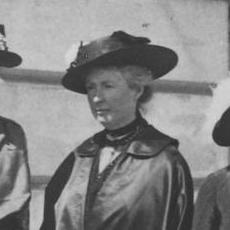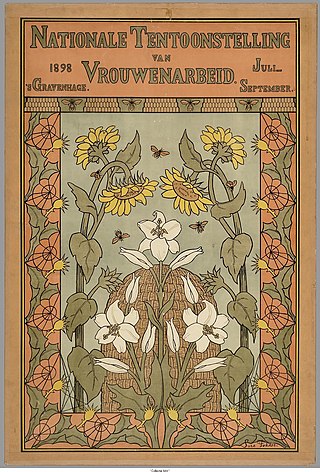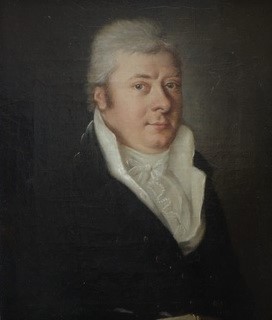Related Research Articles
The Dutch People's Union is a Dutch far-right political party. The party espouses ethnic nationalism, advocates for the preservation of "Germanic Christian culture" in the Netherlands, and is a proponent of a Greater Netherlands.

Van Hogendorp is a patrician family that belongs to the Dutch nobility.

Wilhelmina Drucker was a Dutch politician and writer. One of the first Dutch feminists, she was also known under her pseudonyms Gipsy, Gitano, and E. Prezcier.
Dolle Mina was a Dutch feminist group founded in December 1969 that campaigned for equal rights for women. It was named after an early Dutch feminist, Wilhelmina Drucker. It was a left-wing radical feminist activist group that aimed to improve women's rights through playful and humorous protest demonstrations.

Jkvr. Mariane Catherine van Hogendorp, a member of the Van Hogendorp family, was a Dutch feminist. She founded the Nederlandsche Vrouwenbond ter Verhooging van het Zedelijk Bewustzijn.

1001 Vrouwen uit de Nederlandse geschiedenis is a compilation of 1001 biographies of famous women of the Netherlands spanning roughly 1700 years.

Catharine van Tussenbroek was a Dutch physician and feminist. She was the second woman to qualify as a physician in the Netherlands and the first physician to confirm evidence of the ovarian type of ectopic pregnancy. A foundation that administers research grants was set up in her name to continue her legacy of empowering women.

Atria, institute on gender equality and women's history is a public library and research institute in Amsterdam dedicated to research and policy advice on gender equality and to the documentation and archival of women's history. Its previous names were International Information Centre and Archive for the Women's Movement (IIAV) (1988-2009) and Aletta, Institute for Women's History (2009-2013).

Beatrix de Rijk (1883–1958) was a pioneering Indonesian Dutch aviator. On receiving her pilot's licence from the Aéro-Club de France on 6 October 1911, she became the first Dutch woman pilot.

Willemijn Posthumus-van der Goot was a Dutch economist, feminist and radio broadcaster. As the first woman to attain a doctorate in economics in the Netherlands, her work focused on the impact of working women on the economy. Recognizing that there were few sources, she joined with other feminists to create the International Archives for the Women's Movement in 1935. Writing reports on women's work, she refuted government claims that women working outside the home was of no benefit. First proposed in 1939, the Household Council, which she saw as an organization to foster training and organize domestic laborers was instituted in 1950. She founded the International Association of Women in Radio, as an organization for professional development and networking in 1949. As a peace activist, she was involved in the promotion of pacifism and believing women had unique qualities for solving world problems, she established the International Scientific Institute for Feminine Interpretation. In 1982, in recognition of her significant contributions to the Dutch Women's Movement, Posthumus-van der Goot was appointed as an officer in the Order of Orange-Nassau. In 2008, she, her husband and sister, were honored as Righteous Among the Nations by the government of Israel, for their fostering children during the Dutch occupation by the Nazis.

Cornelia Ramondt-Hirschmann was a Dutch teacher, feminist, pacifist and theosophist active in the first half of the twentieth century. She was one of the women who participated in the push by pacifist feminists during World War I for world leaders to develop a mediating body to work for peace. The culmination of their efforts would be the achievement of the League of Nations when the war ended. Between 1935 and 1937, she served as one of the three international co-chairs of the Women's International League for Peace and Freedom (WILPF).

Johanna Wilhelmina Antoinette Naber was a Dutch feminist, historian and author during the first feminist wave. She was one of the three founders of the International Archives for the Women's Movement (1935), now known as Atria Institute on gender equality and women's history, and was herself a prolific author of historical texts about influential women and the women's movement.

Margaretha Anna Sophia Meijboom or Meyboom was a social worker, feminist and translator of Scandinavian literature into Dutch. She introduced many Scandinavian writers to the Netherlands, such as Henrik Ibsen, Bjørnstjerne Bjørnson and Selma Lagerlöf. She resisted the idea that a woman's role in society was in the home, and founded several cooperative organisations to further women's economic independence.
Universiteiten van Nederland (UNL), previously Vereniging van Universiteiten until November 2021, is a trade group of government-funded research universities, including three special universities, and the Open University of the Netherlands. It formed as the Vereniging van Samenwerkende Nederlandse Universiteiten in 1985, as a successor to the Academische Raad.

Countess Anne Philippine Madeleine van Heerdt tot Eversberg-Quarles van Ufford was a Dutch feminist, artist, and peace activist. She was involved, among other things, as a board member of the Dutch Association for Women's Suffrage and as acting president of the World Union of Women for International Peace.

Bertha "Betsy" Bakker-Nort was a Dutch lawyer and politician who served as a member of the House of Representatives for the Free-thinking Democratic League (VDB) from 1922 to 1942.

Nationale Tentoonstelling van Vrouwenarbeid 1898 was a national exhibition which took place in The Hague in The Netherlands 9 July – 21 September 1898.

Nancy Sophie Cornélie "Corry" Tendeloo was a Dutch lawyer, feminist, and politician who served in the House of Representatives for the Free-thinking Democratic League (VDB) from 1945 until 1946 and then for the newly-formed Labour Party (PvdA) until her death in 1956. Born in the Dutch East Indies, Tendeloo studied law at Utrecht University, during which time she made contact with people within the women's rights movement. She became politically active in the 1930's and was elected to the Amsterdam City Council for the VDB in 1938. After World War II, Tendeloo was appointed a member of the House of Representatives for the VDB in the national emergency parliament, formed to rebuild the country and organise elections. In 1946, the VDB merged with other parties into the PvdA, which Tendeloo represented in parliament. She sat on two select committees and spoke in favour of women's rights issues.

Changuion is a Dutch, French and South African family of which a member was ennobled in the Netherlands in 1815.

Jonkheer François Daniël Changuion, commonly known as Daniël Changuion, was a Dutch administrator and diplomat. Some of his descendants settled in South Africa in the nineteenth century.
References
Citations
- ↑ Grever & Waaldijk 2004, p. 38.
- 1 2 Nederlandse Vrouwen Raad 2013.
- ↑ de Vries 2015.
- 1 2 Leydesdorff 2009.
- ↑ Grever & Waaldijk 2004, p. 37.
- ↑ De Nationale Vrouwenraad 1911, p. 4.
- ↑ De Nationale Vrouwenraad 1911, pp. 5–6.
- ↑ De Nationale Vrouwenraad 1911, p. 7.
- ↑ Grever 1994, pp. 65–66.
- ↑ Atria 1998.
Bibliography
- de Vries, Petra (23 January 2015). "Hogendorp, Mariane Catherine van (1834-1909)". Huygens Ing (in Dutch). Amsterdam, the Netherlands: Digitaal Vrouwenlexicon van Nederland. Archived from the original on 28 December 2016. Retrieved 18 May 2017.
- Grever, Maria; Waaldijk, Berteke (2004). Transforming the Public Sphere: The Dutch National Exhibition of Women's Labor in 1898. Durham, North Carolina: Duke University Press. ISBN 0-8223-3296-5.
- Grever, Maria (1994). Strijd tegen de stilte: Johanna Naber (1859-1941) en de vrouwenstem in geschiedenis [Fight against silence: Johanna Naber (1859-1941) and the woman voice in history] (in Dutch). Hilversum, The Netherlands: Uitgeverij Verloren. ISBN 90-6550-395-1.
- Leydesdorff, Selma (1 March 2009). "Modern Netherlands". Jewish Women's Archive. Brookline, Massachusetts: Jewish Women: A Comprehensive Historical Encyclopedia. Archived from the original on 12 October 2016. Retrieved 18 May 2017.
- "Archief Nationale Vrouwenraad van Nederland" [Archive of the National Woman's Council of the Netherlands]. Atria (in Dutch). Amsterdam, the Netherlands: Atria Institute on gender equality and women's history. 1998. Retrieved 19 May 2017.
- De Nationale Vrouwenraad van Nederland [The National Women's Council of the Netherlands](PDF) (Report) (in Dutch). The Hague, The Netherlands: Drukkerij “Humanitas”. 1911. Archived from the original (PDF) on 19 May 2017. Retrieved 19 May 2017.
- "NVR in jaartallen" [NVR by years]. Nederlandse Vrouwen Raad (in Dutch). The Hague, The Netherlands. 14 August 2013. Archived from the original on 25 March 2016. Retrieved 18 May 2017.